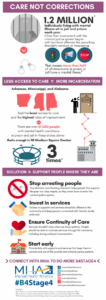1.2 million individuals living with mental illness sit in jail and prison each year.
Often their involvement with the criminal justice system begins with low-level offenses like jaywalking, disorderly conduct, or trespassing.
In 2015, The Sentencing Project ranked the states based on the number of people incarcerated in state prison per 100,000 residents.2 Comparing state-by-state rates of incarceration with the access to mental health care ranking shows a strong positive correlation between rates of adult who are in the criminal justice system and lack of access to mental health care (r =.69, p=000).
The states with less access to mental health care have more adults who are in the criminal justice system.
Six out of 10 of the states with the least access to mental health care also have the highest rates of incarceration.
These states include:
- Alabama
- Arkansas
- Mississippi
- Texas
- Georgia
- Florida
The chart below shows the ranking of states based on the rate of adult incarceration (per 100,000 people). The access to care ranking is the corresponding sum of scores for each state. The ten states with the least amount of access to care are highlighted in red, and the 10 states with the most access to care are highlighted in purple.

Solutions to incarceration
Invest in real diversion
There has been a rise in the use of diversion programs such as mental health courts or drug courts across the country. These courts work in collaboration with mental health and substance use treatment providers to help individuals who have mental health or substance use problems. In order to access the treatment available in mental health or drug courts, a person must first plead guilty to a crime and be subject to incarceration. Evaluation of mental health and drug courts have shown questionable efficacy and significant challenges. A much better option is to explore the use of pre-booking diversion. People with mental health problems come into contact with police for factors related to their mental health problems. These factors should not be a reason for incarceration. When possible, individuals who do come in contact with police should be diverted to other options like treatment or peer run crisis respite models and never sent to the police station for booking.
Invest in services
If there is a correlation between access to mental health care and incarceration the next important step is to research how systemic changes in access to mental health care can cause a reduction in incarceration. Treatment such as Assertive Community Treatment and Multisystemic Therapy already have strong evidence for reducing days of incarceration. Investing in mental health and substance use services for all people will reduce the likelihood that individuals will ever face incarceration in their lifetime.
Ensure continuity of care
When people enter into the criminal justice system, their access to treatment changes. Many will lose insurance benefits and services. For those who begin receiving services while incarcerated, many lose access, sometimes immediately, when they return to the community. This can be particularly dangerous for people who suddenly lose access to prescribed medications. To ensure the best possible outcomes for individuals, which includes keeping them out of jails and prisons, it is essential that we create systems that support people as they transition both in and out of incarceration. People should receive appropriate supports while incarcerated and have a plan that connects them to community-based services and with adequate insurance coverage prior to returning to the community.
Start early
To prevent incarceration, we must begin early and support students in schools. Students with disabilities are more than twice as likely to be suspended.3 Students who are suspended or expelled are almost 3 times as likely to be involved with the juvenile justice system within the next year.4 Ultimately, students who have been in the juvenile justice system are more likely to end up in the criminal justice system. Lack of supports in schools, which often lead to suspension or expulsion, also results in students with disabilities having the lowest graduation rate of any group at 63%— about 20% lower than the national average.5 Dropping out of school is another factor that puts individuals at high risk for incarceration. The research and experiences of many people show the number points at which we can intervene and keep kids in schools. Things like Positive Behavioral Intervention and Supports, screening, and community based resources can keep kids connected and in their communities. In order to have the best outcomes both for individuals and for society, we must provide students supports where they are—in school.
Care not corrections infographic


